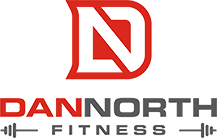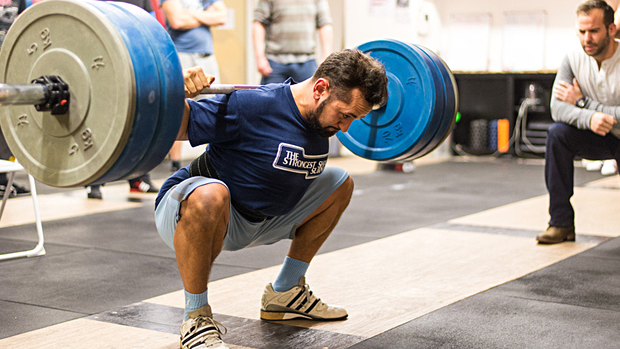
Back Squat – Finding Your Weak Link and Making it Strong AF
- DAN NORTH
- Exercise Technique Squat Strength Training Tips
The back squat is essentially a very simple movement to understand. You load a bar onto your traps, sit down, and stand back up. When you really break it down, you’ll notice different portions of the squat require different strengths.
You are only as strong as your weakest link.

If you’ve ever squatted heavy before, you’ll know there are certain points in the squat that are harder than others, and that ultimately comes down to the individual. You might struggle during the lockout, you might have trouble getting out of the bottom position, or you may have issues during the eccentric loading phase. Depending on your training background and your strengths, different segments of the back squat are going to be more challenging than others.
That is, until you begin to troubleshoot and make your weak link(s) stronger.
Let’s break down common weaknesses in the back squat and how you can start attacking them.
COMMON WEAKNESSES IN THE BACK SQUAT INCLUDE:
- Weak upper back and rounding of the thoracic spine (upper back/shoulder area).
- Lower back pain or hyperextension.
- ‘Crashing’ down to the bottom with minimal to no eccentric loading.
- Getting stuck in the bottom of the squat.
- Struggling during the ‘sticking point’ or lockout of the squat.
These are all very common issues that can be improved if you address them correctly. Now that you can see there are various weaknesses you can experience during the squat, you should also know that when it comes to corrective exercises, one size does not fit all. What I mean by that is, when you are trying to make your back squat stronger, you are going to have to incorporate different training protocols depending on which weaknesses you are trying to improve.
Lets start tackling these weaknesses now.
1. CREATE A STRONGER SHELF WITH UPPER BACK EXERCISES.
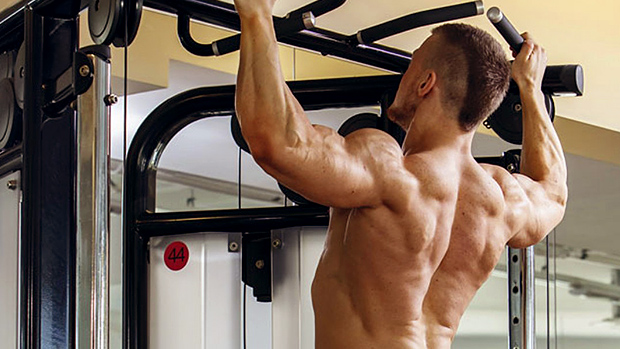
It all starts with a strong back and a rock solid core. Think about the back squat, you are literally supporting weight on your back. Working on developing your upper back muscles will create a support system and a ‘shelf’ for the bar to rest on during your squat.
The back squat is a leg dominant movement, but you won’t be able to perform it safely and efficiently without strengthening the upper back.
Horizontal rowing variations, shrugs, farmer carries, isometrics…you have a lot of exercises to choose from. When it comes to strengthening the upper back muscles, I would advise neglecting the urge to do heavy ass dumbbell rows or barbell rows every time you train, or at all. Very rarely are these exercises performed efficiently in a way that actually strengthens the muscles you are trying to target. Often, ego can play a role with these types of movements and alters the effect of the exercise.
To create a stronger support system in the upper back, you want to specifically dial into the upper back muscles by eliminating compensation of form and really breaking down the upper/mid traps, teres major/minor, and posterior deltoids.
TO DEVELOP SOLID MUSCLE MASS AND CREATE A STRONGER SHELF IN THE UPPER BACK, STICK TO 8-12 REPS FOR ABOUT 3-4 SETS FOR THESE EXERCISES. USE THESE AS STARTING POINTS AND IMPLEMENT THEM INTO YOUR CURRENT ROUTINE.
UPPER BACK EXERCISES FOR A STRONGER BACK SQUAT
***ALL EXERCISES LISTED IN THIS ARTICLE HAVE VIDEO LINKS EMBEDDED IN THEM. CLICK TO WATCH A VIDEO DEMONSTRATION***
Bent over row variations with barbell and dumbbells
TRAIN YOUR CORE (OTHER THAN DURING THE MAIN LIFTS).

Squatting with a barbell on your back isn’t exactly a natural movement. When a bar is positioned behind your neck that puts a lot of pressure on the spine and lower back muscles. You will often hear people complaining about lower back pain when they squat and when you see them actually do it, you’ll notice a hyperextension in the lumbar spine. This often is a sign that the core is disengaged and is therefore not supporting the lower back. Now all of that weight behind your neck is applying direct pressure to your spine since there is no backup support from the core muscles.
I cannot overemphasize how important a strong core is when you’re squatting. If you’re squatting correctly and are going heavy enough, you’ll actually be training your core while you squat. However, I would recommend going a little further with your approach.
Your core consists of the muscles surrounding the abdominal wall and your lower back. So when you are training your core, implement exercises that not only focus on strengthening the abs, but the posterior chain as well. Usually exercises that involve a standing, prone or supine position with healthy amounts of extension, flexion, lateral movement, and isometric or eccentric loading are great.
Incorporate these exercises into your current training plan. You can use them as activation drills before lifting and on your off days in between sessions.
Core and lower back exercises for a stronger back squat:
Dead bug variations (5-10 reps per side for 2-3 sets)
Birddog variations (5-10 reps per side for 2-3 sets)
Biering Sorensen extension (60 sec hold, 30 sec rest for 3 rounds)
Romanian deadlift (6-12 reps for 3-4 sets)
Banded good morning (6-12 reps for 3-4 sets)
3. Work on your hips and hamstrings.
When you sit down into your squat, you’re going to need strong hips and strong hamstrings to control the eccentric portion of the movement and drive back up to full extension. A major issue when squatting is crashing to the bottom with minimal to no engagement in the hip flexors and hamstrings, leaving no support to spring up from the bottom of the squat.
The majority of the population has tight hips, but that doesn’t mean they are strong. Same goes for the hamstrings, they’re tight, but weak. Ever get a Charlie horse or leg cramp in the hammies? That’s probably a sign they are inactive and need some attention.
Two key strategies to strengthening your hips and hamstrings for a stronger back squat are:
- Eccentric loading
- Isolation/activation drills
If you find you’re having trouble controlling the bar on your descent into the squat, focus on incorporating eccentrics. This isn’t limited to the back squat, you can ‘load up the hips’ with eccentric goblet squats, bodyweight squats, banded pull through’s, or even RDL’s.
Try adding a couple of these variations into your leg day workout.
Eccentric squat (6-12 reps for 3-4 sets)
(bodyweight, goblet, back rack, or front rack squat variation)
Eccentric RDL (6-12 reps for 3-4 sets) (kettlebell, dumbbell, or barbell variation)
Eccentric loaded single leg curl (6-8 reps for 2-3 sets)
Before you even start squatting, you should be warming up with hip and hamstring activation drills. Hip bridges, pull through’s, monster walks, leg curls, or even banded hamstring curls. Don’t limit yourself to just a few exercises, see what feels good and works best for you right now. But adding activation exercises to strengthen the hips and hamstrings before (and after) your squats are going to make you a hell of a lot stronger.
Banded leg curl (10-15 reps for 3-4 sets)
Banded hip bridge with hip flexion (6-10 reps for 3-4 sets)
Standing hip flexion activation (10-15 sec hard isometric hold)
Standing hip flexion activation with kettlebell (10-15 sec hard isometric hold)
4. GET YOUR BOTTOM STRONGER.
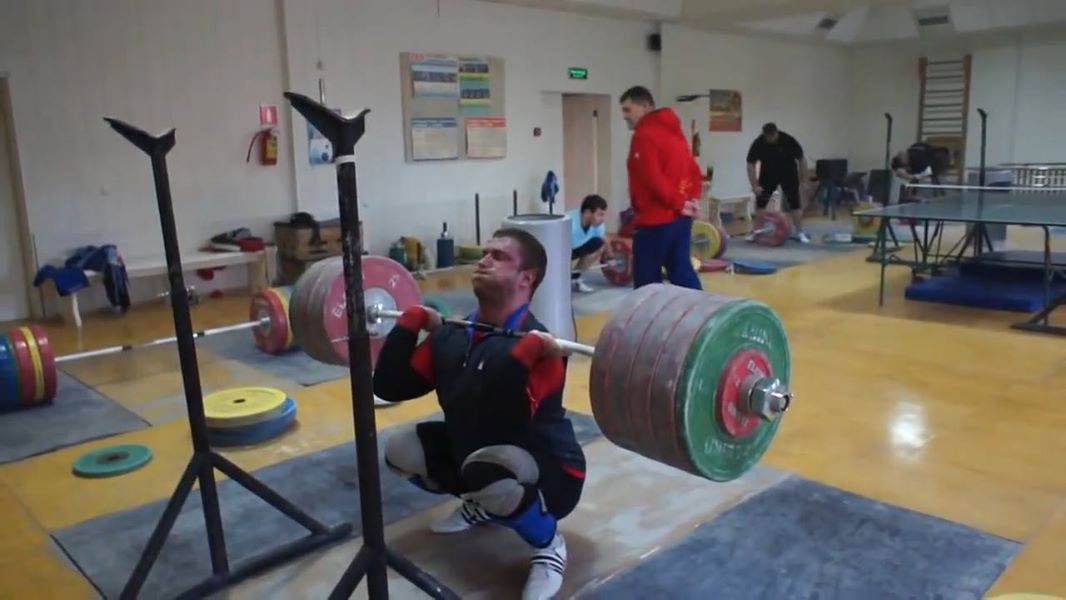
If you feel weakest getting ‘out of the hole’ or coming up from the bottom position of the squat, start strengthening your glutes.
If you’ve ever seen weightlifters, you’ll notice they have big butts. That’s because their whole sport is built around catching weight at the bottom of a squat and standing back up with it. They are powerful from the bottom of the squat, and it is usually the easiest part of their lifts because they’re squatting all the time.
Typically, the average lifter you’ll see squatting at any commercial gym will not go to the depth Olympic weightlifters do. They perform quarter reps without even knowing it, putting all of the attention on the quads. They might even go to parallel during their warm up sets, but the squat gets higher and higher as they start adding weight to the bar.
So, when it comes to squatting to depth or below 90, they have a hard time generating power because their glutes haven’t been trained to be strong in this position.
Lets change this.
Here are a few key exercises I want you to start incorporating to strengthen the glutes and become more powerful out of the bottom of your squats. Don’t limit yourself to the following exercises, simply use them as a starting point and choose two to three to implement into your current routine.
Note: I would use the box jump variations as a warm up tool before squatting or on one of your off days as part of your dynamic effort workouts.
Box squat (2-5 reps for 3-5 sets for strength; 6-12 reps for 3-4 sets for muscle development)
Paused squat (2-5 reps for 3-5 sets for strength; 6-12 reps for 3-4 sets for muscle development)
Barbell thrust (6-12 reps for 3-4 sets)
Single leg hip thrust (6-12 reps for 3-4 sets)
Side plank clamshell (6-10 reps for 2-3 sets)
Seated box jump (2-5 reps for 3-5 sets)
Box squat to box jump (use this as a warm up before squatting to stimulate the central nervous system and prepare you for loading) (2-5 reps for 3-5 sets)
5. CRUSH YOUR QUADS FOR A STRONGER LOCKOUT.
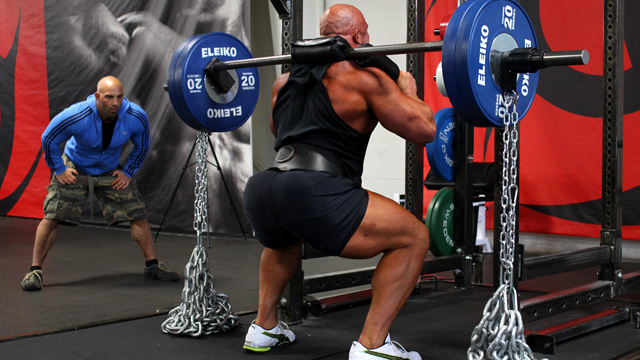
When you break down the back squat step by step, your quads are going to be the prime movers during the lockout. You can get really fancy when incorporating exercises to make your quads grow stronger. You can add bands and chains to your lifts, perform top-end overloaded squats, overcoming resistance isometric squats, the list goes on.
For now, lets start with some of the basics, because a large portion of the lifting population neglects them. Think fundamentals over flash when training to get stronger, especially if you’re not a competitive lifter.
TKE (terminal knee extension) (10-15 reps per side for 2-3 sets)
Goblet squat (8-12 reps for 3-4 sets)
Front squat (6-12 reps for 3-4 sets)
Step up variations (6-12 reps for 3-4 sets)
Bulgarian split squat variations (6-12 reps for 3-4 sets)
Zercher box squat with chains (6-10 reps for 3-4 sets) (even though this is a box squat and strengthens the glutes, the chains add a ton of tension in the quads during both concentric and eccentric phases)
When you are trying to get stronger in any of the main lifts (squat, bench, deadlift, snatch, clean and jerk), break them down into segments and incorporate exercises that will strengthen the supportive muscle groups used during each portion of the movement.
Stay strong,
Dan



